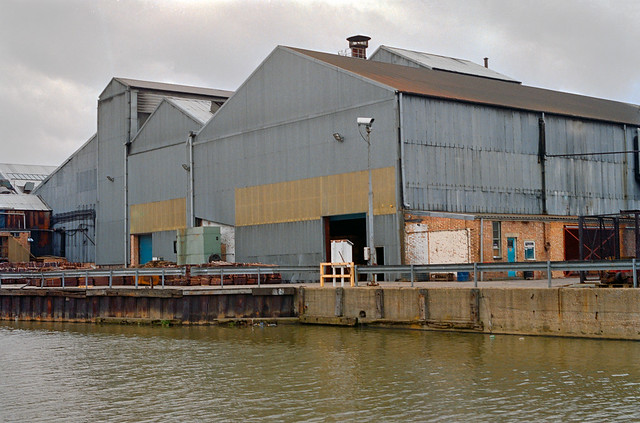More Colour from 1994 in Enfield: In More Ponders End, Enfield Wash, Palmers Green & Brimsdown 1994 I posted a set of pictures made in the first three months of the year. This post includes some more taken in March 1994 mainly along by the Lea Navigation in the London Borough of Enfield and ends with a couple taken in April or May.
My archives from back then are a little disorganised but I’ll try hard not to post any that I’ve previously posted, although a one here is from a site where I’ve previously posted a panoramic images.
The Lea Valley was an important industrial area of London well into the 20th century and had been the source of some key inventions, including the start of the electronics industry. Some of the factories were along the river, perhaps originally on sites that had made use of its wharves, but now all reliant on road transport, with all of Brimsdown between the railway and the canal being huge industrial estates off Mollinson Avenue.
Here the separation of industry from the canal was emphasized with a concrete fence, now rather decaying at the edge of the bank and tell fence topped with barbed wire at an angle to keep intruders from the canal out of the site.
I don’t remember exactly where at Brimsdown this factory was, but like the rest of the industry here it will since have been demolished, replaced by large distribution sheds, some set well back from the water and almost hidden by trees and bushes growing unfettered along the water’s edge.
There are houses and a few shops at Brimsdown on the other side of the railway line in what is perhaps part of Enfield Wash, which then included this hairdressers. The Sun’s March 1994 topless ‘Page 3 girl‘ in the calendar (also part reflected in the mirror at right) confirms the date of the picture.
In a previous article I posted a panoramic view of Columbia Wharf looking down from the Lee Valley Road. Here from a little further East on that road with the navigation in the foreground you see the wharf and background the Ponders End Flour Mills, the gas holder and four tower blocks in Ponders End.
Much redevelopment has gone on in Ponders End and only one to those towers remains and there is no gas holder. But the shed at the wharf is still there and in use although Abbey Stainless Components Ltd are no longer there, nor is that large crane and the van boasting ‘NORTH LONDON’S CARRIER PIGEONS IN TRANSIT has long flown the coop.
A more pastoral panorama of Ponders End with Wright’s Flour Mills and the four towers in the background.
Lady Jayne remains a well known brand in the Ladies hair trade. I think this shop was probably in the High Street, much of which has now been redeveloped.
Tyre Services Tyre & Exhaust Centre at 151 High Street on the corner with Stonehorse Road, a short ‘No Through Road’ off the High Street. This building was still there in 2022 but had became HiQ and then National Tyres and Autocare – a Halfords company and was by then permanently closed. I expect its days were numbered. Much of the area of the High Street around it was redeveloped around ten years ago.
More colour pictures from 1994 to follow in later posts.
Flickr – Facebook – My London Diary – Hull Photos – Lea Valley – Paris
London’s Industrial Heritage – London Photos
All photographs on this page are copyright © Peter Marshall.
Contact me to buy prints or licence to reproduce.































